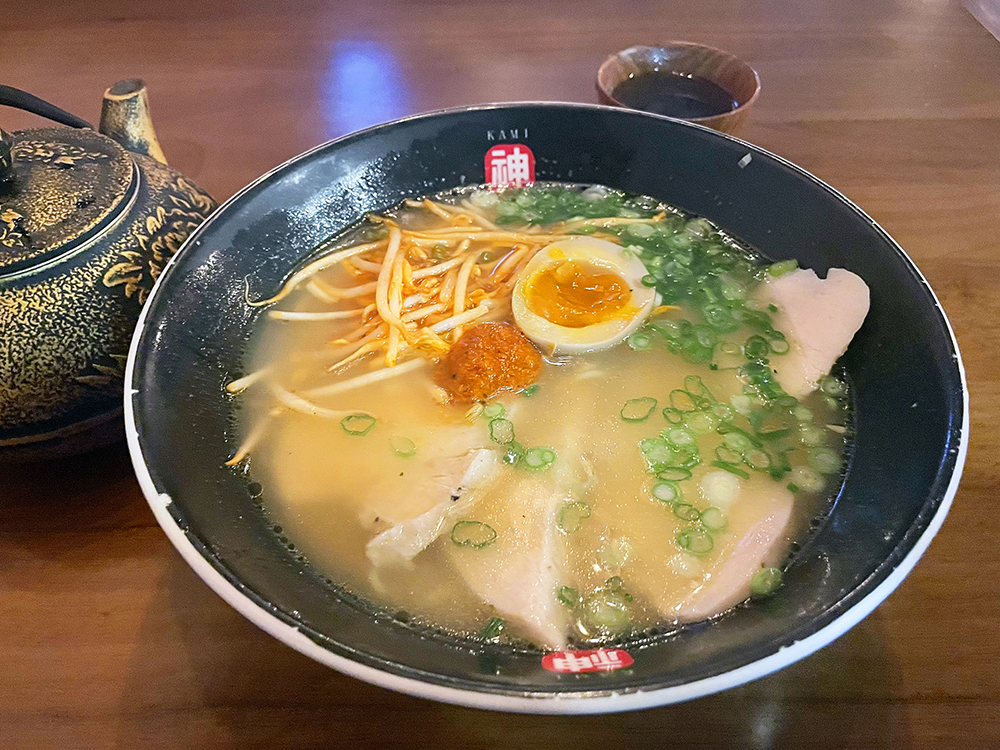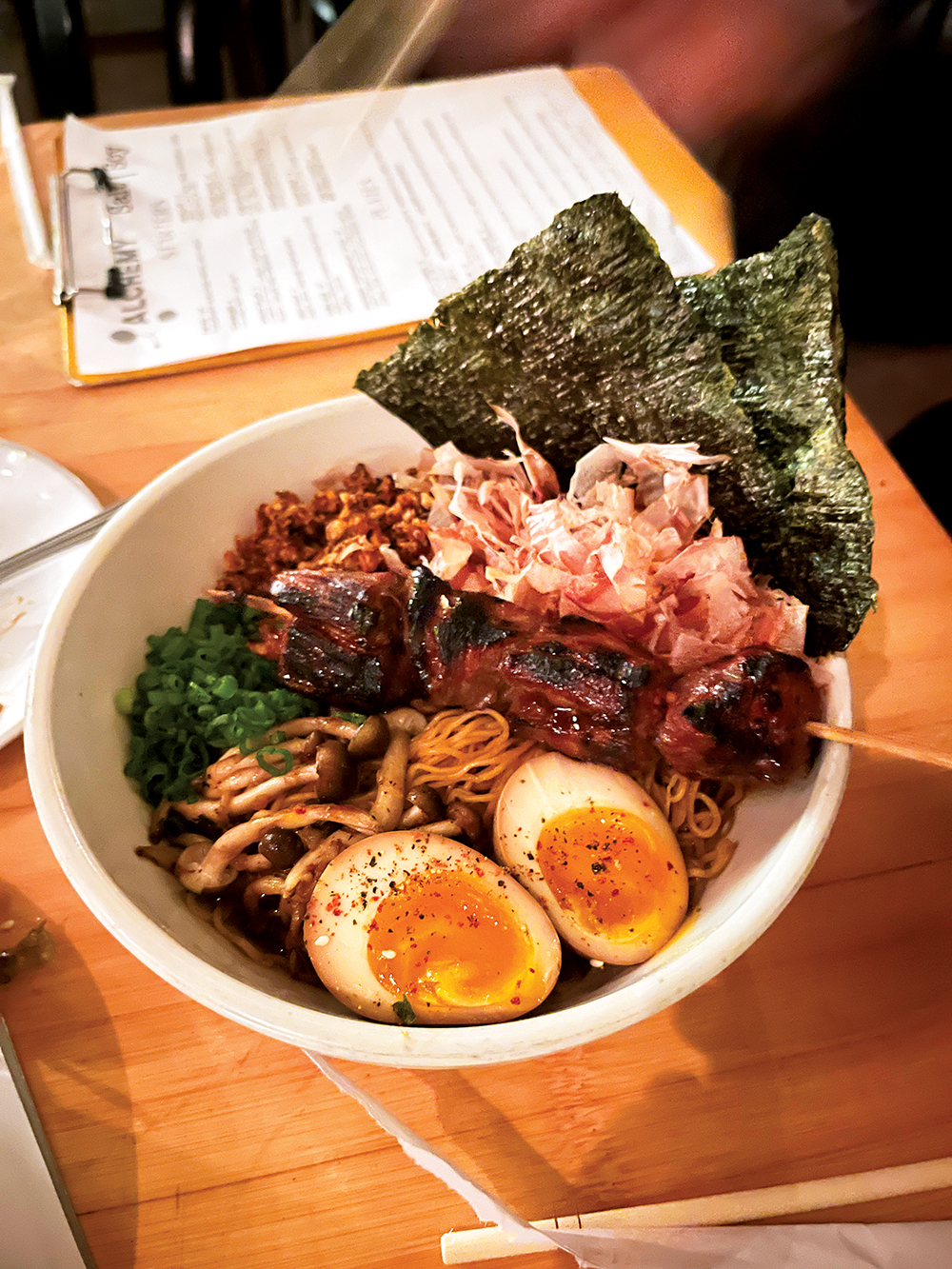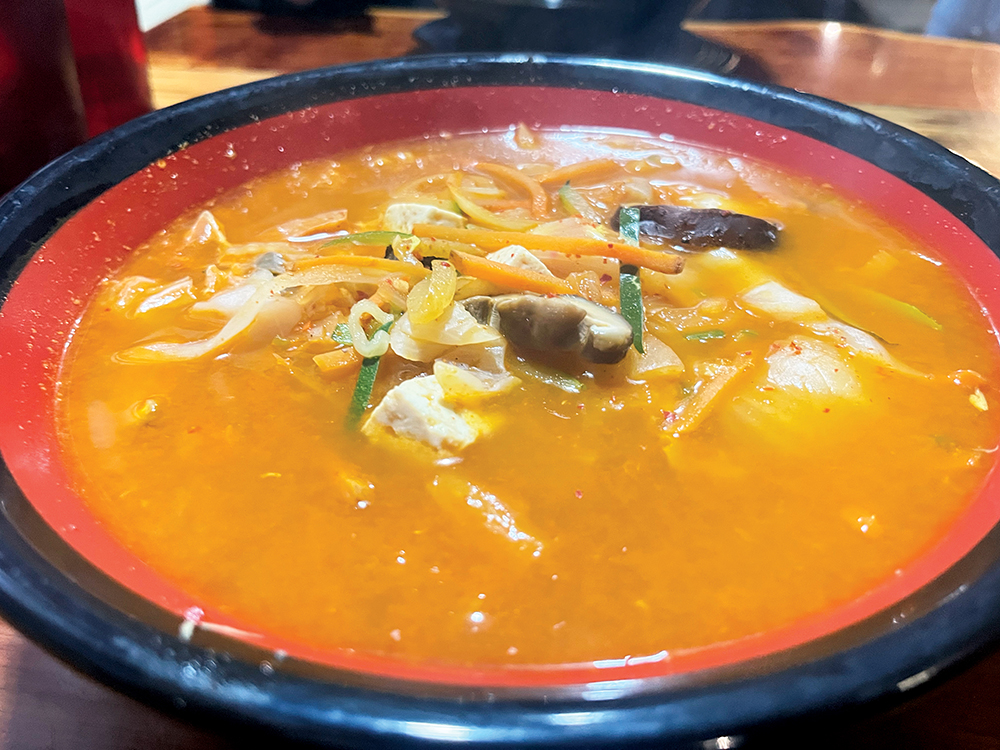The Memphis cold snap is threatening to roll through any day — or week? — now, and that means hungry Memphis minds will soon turn to hot bowls of soup to get through the long winter ahead. Rather than stick to the classic chicken noodle or tomato soups, we decided to pursue those of a more Japanese tilt. There’s been a bit of a ramen boom in Memphis in recent years, and we set out to try some of the different options. Alas, our stomachs are not bottomless, so we didn’t make it to every spot in town. But our adventures took us to several new and classic spots alike, all staking a claim to having the best bowl of noodles.

Good Fortune Co.
Got noods? Good Fortune Co. certainly does, and the Downtown Memphis restaurant has been drawing in oodles of diners since it opened in 2021. Co-founded by Sarah Cai and Arturo Leighton, Good Fortune Co. has become more than just an eatery. With its neon “Send Noods” sign hanging near the front, an enormous pastel-bright Ghibli-inspired mural stretching across a full wall, and the always photographable fish-shaped taiyaki desserts, it’s a Downtown destination at 361 South Main Street. Want to have a great time? Start your night at Good Fortune Co.
Leighton and Cai have the food to match those pulsating vibes. What sets Good Fortune apart from other ramen joints is a fervent commitment to make everything by hand. That’s right: Every noodle and dumpling that comes out of the kitchen was made from scratch, and such an approach isn’t for the faint of heart. That means extra hours of prep work every day to make sure there’s enough for the dinner rush. The whole venture is a labor of love, as the two have often said.
My personal favorite at Good Fortune Co. is the coco curry ramen, a delicious, heady dish that incorporates more than 20 different ingredients. In my second life as food editor for Memphis Magazine, the coco curry made it onto my top new dishes list for this year, and got the gears rolling on pursuing a ramen feature here at the Flyer. An OG menu item, the coco curry is perhaps the neatest encapsulation of Good Fortune’s ethos as a restaurant. “[Curry ramen] is not something we’ve seen that people are making from scratch here in the city,” Leighton told me over the phone after one of my many visits to Good Fortune in 2023. “We knew if we were going to put one on the menu, we knew it would follow the ethos of what we do, which is ‘scratch-made’ food. So we make our curry paste from scratch using galangal, ginger, lime, plenty of things like that to give it a unique, Southeast Asian flavor profile.”
The coco curry is served with tofu in lieu of pork, chicken, or other meats. That almost came about as a happy accident during the R&D phase when Leighton and Cai were coming up with a menu. “We’d finished the recipe and found that we had a fully vegan dish, and we thought it was good enough already,” said Leighton. “All the ingredients that go into the curry are totally vegan, there’s no pork fat, no animal fats, it’s just coconut and some amazing aromatics. We thought adding a meat component to it would distract from all of the great flavors we’d put in there.”
And stay tuned: There may be some changes to Good Fortune’s menu next time you walk through the doors. One new item to look out for is the birria dumplings, an Asian-Latin fusion dish. Stop on by to see what other surprises have been cooked up, and enjoy a piping hot bowl of noodles while you’re at it. And don’t forget to order the wings, either. — Samuel X. Cicci

Kami Ramen Bar
Regan Chen believes ramen is so good, he and his business partner opened four locations of Kami Ramen Bar in the Memphis area and two in Houston, Texas.
That’s been since the middle of the pandemic.
“First of all, I’ve been a huge Japanese ramen fan from back in the day when I was living in China,” says Chen.
Ramen originated in China, says Chen, but the formula went through several stylistic changes when the idea was taken to Japan. “When the Japanese took Chinese ramen back to Japan, they developed their own Japanese-style ramen in some ways.”
Instead of the way some dishes are “Americanized” when they arrive in the United States, Japan took Chinese ramen and “Japanized” it, Chen says.
Tonkotsu ramen broth is primarily made with pork neck bone, Chen says. “They simmer the bones with all kinds of vegetables over 10 or 12 hours to get the condensed, really creamy broth. That’s the key to tonkotsu.”
Chinese ramen broth is “made with all kinds of bones, like chicken bones, pork bones, beef bones. All kinds of bones. Different regions of the China area have different kinds of ramen.”
Chen got the idea to open an authentic Japanese ramen restaurant when he moved to Memphis five years ago. “Back in the day when I was in Houston, I liked trying different ramen places. Some of the ramen is really good. When I first moved to Memphis, I was trying to find a good ramen spot.”
But he couldn’t find exactly what he was looking for. “So, I decided to open my own ramen spot.”
Chen says he wanted to bring “the real, authentic — and I think it’s great — ramen to the Memphis people. So, I got excited and then I started doing my homework. I was a cook for almost 10 years back in China, so I know how to do Japanese ramen with the help from Japanese friends who own ramen shops in Japan. They taught me the recipe and how to do it.”
Chen opened his first location, Kami Ramen Bar — East Memphis at 5865 Poplar Avenue, Suite 110 — in the middle of the pandemic. Business wasn’t great. That changed about a year later because of word of mouth, he says. “Everyone was coming to try it. A lot of people liked it. We took off.”
On a recent chilly afternoon, I opted for the spicy chicken ramen over the “Slurp Up Cilantro” chicken ramen dish at the Kami Ramen Bar in Collierville. I eat cilantro, but it isn’t on my top 10 list of favorite herbs. According to the menu, the spicy chicken dish is made with chicken stock as well as chicken chashu, spicy bean sprouts, marinated egg, and green onion.
I ordered mine mild instead of the spicy or hot options. The noodles were tasty and the broth was so delicious. And soothing. The perfect dish — along with a pot of hot green tea with lemons — for a cold day.
Some customers prefer the chicken ramen dishes. “The broth is more smooth compared to pork broth. It [pork broth] is creamy. But the chicken broth is smooth and clear.”
But whether they’re ordering the chicken, pork, vegetable, or seafood ramen, Chen says, “Above all, it’s the freshness.”
Chen personally likes the texture of the noodles, which are cooked al dente. The noodles are firm. So, they can be chewed while eating the broth. — Michael Donahue

Alchemy Memphis / Salt|Soy
There’s a new arrival to Memphis’ ramen scene in Cooper-Young.
Nick Scott now features shoyu ramen on his menu at Alchemy Memphis. According to the menu, the dish is made with a “rich pork broth, wood ear mushroom, marinated egg, green onion, chili crisps, nori, and katsuobushi.” Diners can add tofu, pork belly, and beef hanger steak.
Scott, Alchemy Memphis’ owner, and ramen go way back to when he was a teenager “living on a budget.” “When I didn’t have any money we were buying Top Ramen and really dressing it up.
“This sounds crazy — my daughter is into this — but if you make straight Top Ramen, cook some bacon in it, and throw a piece of sliced American cheese on top of it, it’s fantastic. The cheese kind of melts into the ramen and everything. That’s truly a broke person food.”
Scott began cooking Asian-style cuisine at Wally Joe, which was owned by chef Wally Joe, now owner of Acre Restaurant. “It wasn’t exactly Asian food, but there was always an Asian influence there. He took French and Southern and threw some Asian in there and kind of melded it together.”
Scott went on to do more Asian cooking at the old Bluefin and the old Dough restaurants.
He began cooking shoyu ramen at the old Salt|Soy pop-ups at Alchemy during the pandemic. “It worked well as a to-go food.”
Scott then added it to the menu when he moved Salt|Soy into a brick-and-mortar location on Broad Avenue.
When the Salt|Soy lease on Broad was about to come to an end, Scott decided to combine Alchemy Memphis and Salt|Soy into one restaurant. The Salt|Soy part of the restaurant is the food — “the South meets Japan kind of thing. And Alchemy is the cocktails. We’ve added an Asian influence to some of those cocktails to kind of complement the food.”
Scott’s version of shoyu ramen was a bit different from the one created by Alchemy Memphis chefs John Green and John Taylor.
The version made by Green and Taylor is “very similar” to the one at Salt|Soy, Scott says. They’re both “based on a traditional shoyu ramen. You kind of build it to make it your own. Add proteins and tofu.”
Originally, Scott’s shoyu ramen was “more churched up. Where you take pork belly, roast it, roll it up, slice it, and add the slices.”
Now, he says, “We do a pork belly skewer yakitori style.”
That adds the smokiness to it, he says. “We grill it on the konro grill, which is the traditional grill” in Japan.
Ramen is “a fairly easy dish to pull off. The trick is getting the broth right. You want those noodles to be chewy. There’s a trick to that. Get it out and eat it quickly.”
The ramen in Japan is “unlike the ramen that everybody is accustomed to in America. The noodles aren’t dried. They’re fresh. They get blanched very quickly, rinsed, and then poured into the broth.”
Whether fresh or dried, Scott says, “You don’t want to overcook those noodles. You want them to have an authentic kind of ‘to the tooth’ chew to them.” — MD

The Crazy Noodle
It seems like The Crazy Noodle has always been there for me. When we needed a quick dinner option that everyone was happy with, we picked The Crazy Noodle. When a snowstorm during college forced most businesses to close their doors, I defrosted my FJ Cruiser, cranked up the four-wheel drive, and braved the icy streets until The Crazy Noodle’s lights shone through the darkness, beckoning us towards bowls of Korean ramen that kicked the spice up a notch and fogged up our glasses.
There’s always a bit of a wait at The Crazy Noodle at 2015 Madison Avenue, but anyone who’s been knows that it’s always worth it. I almost always order the jjamppong (a super spicy seafood soup that catapults the tastebuds straight into the fires of hell, in a fun way), but for the sake of journalism, this time I plumped for the spicy Korean ramen. Korean ramen, I’ve been told, generally uses simpler ingredients than its Japanese counterpart, and the spicy Korean ramen made for an excellent evening of comfort food, just like so many of the other delectable options. The smooth, peppery broth with onions, carrots, zucchini, cabbage, and green onions, mixed in with a little egg, is easy to inhale even as the spices tickle the back of your throat with a light, pleasurable burn.
For a unique dish, try the cheese ramen, boasting a broth made with a mix of shredded mozzarella and mild cheddar, and topped with a fried cheese mandu (dumpling). It was like a grilled cheese in a bowl: simple, delicious, and soul-warming all at the time, with a thicker consistency that reminded me almost of egg drop soup. I tend to stick with spicier options, but when the snow finally rolls in, I may have to make a return trip for more cheese. — SXC
The aforementioned restaurants are but four establishments that serve up a delicious bowl of ramen, but there are plenty of others that deserve a visit, such as Overton Square’s Robata, the two Flame Ramen franchises in Midtown and Downtown, or Subarashi on Highland. Once you’ve tried ’em all, local markets like Viet Hoa have all the requisite ingredients in case you want to try making your own bowl. Whatever the case, don’t be afraid to slurp!
